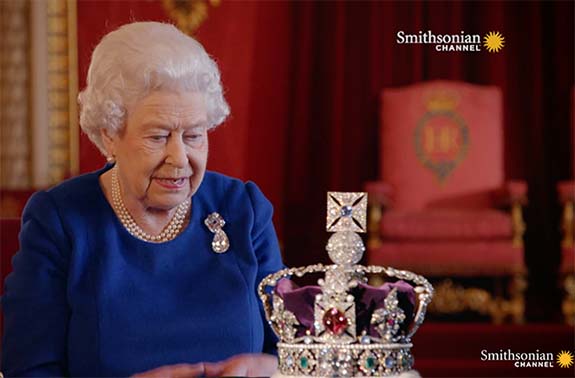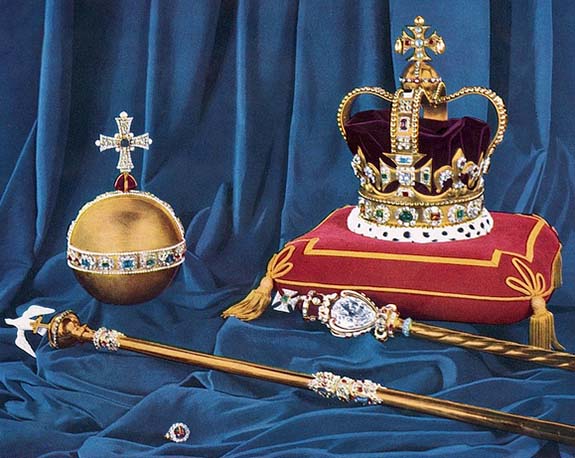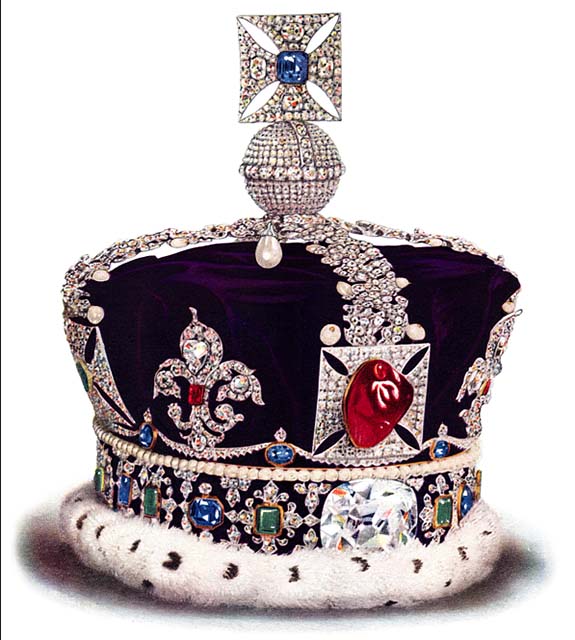January 15th, 2018
Priceless gems from the British Crown Jewels were hidden from the Nazis in a biscuit tin and buried underground at Windsor Castle during World War II, a BBC documentary revealed last night.

Fearing an invasion, King George VI ordered that the most precious jewels — including the Black Prince’s ruby and Saint Edward’s sapphire — be removed from the royal crowns, stashed in a Bath Oliver biscuit tin and buried under a sally port, which is a secret exit from the castle used in times of emergency.

The treasures were placed deep in the ground at the royal family's country residence in Berkshire and secured with steel doors. The limestone excavation was filled in with soil and covered with turf. Queen Elizabeth II, who was only 14 at the time, first learned of her father's ploy during her BBC interview with Alastair Bruce.
"What was so lovely was that the Queen had no knowledge of it," Bruce noted. "Telling her seemed strangely odd."
Some historians speculated that the royal gems had been whisked away during the war to a vault in Canada or a cave in Wales. But, confidential correspondence from Sir Owen Morshead, the royal librarian, to Queen Mary, the mother of George VI, finally uncovered the secret of the biscuit tin. The British Crown Jewels — 23,578 in all — are currently under armed guard in the Jewel House at the Tower of London.

During the interview, the 91-year-old monarch got to take a close look at the Imperial State Crown, the stone's from which were remounted for her father's coronation in 1937. The crown is set with 2,868 diamonds, 17 sapphires, 11 emeralds, hundreds of pearls and a famous ruby that's not actually a ruby.
The Queen pointed out that the 2lb 13oz crown has been reduced in height since her father wore it. She also joked that it's important not to look down when wearing the crown as your "neck would break."
She told Bruce that her favorite gem in the crown is the Black Prince's ruby, which is, in fact, an irregular cabochon red spinel weighing 170 carats. The stone is set in the cross above the 317-carat Cullinan II diamond at the front of the Imperial State Crown and its history dates back to the middle of the 14th century.
The Queen seemed to be saddened by the plight of the pearls mounted in the crown. She said they are “not very happy now” and had been “hanging out for years.”
“I mean, the trouble is that pearls are sort of live things and they need... warming,” she said.
Princess Elizabeth ascended to the throne in 1952 at the age of 25 after her father died unexpectedly.
The BBC documentary was broadcast by the Smithsonian Channel on Sunday night.
Credits: Queen Elizabeth II screen capture via Smithsonianchannel.com; British Crown Jewels, including Saint Edward's Crown, by United Kingdom Government [Public domain], via Wikimedia Commons; Imperial State Crown showing Black Prince's ruby by Cyril Davenport (1848 – 1941) [Public domain], via Wikimedia Commons.

Fearing an invasion, King George VI ordered that the most precious jewels — including the Black Prince’s ruby and Saint Edward’s sapphire — be removed from the royal crowns, stashed in a Bath Oliver biscuit tin and buried under a sally port, which is a secret exit from the castle used in times of emergency.

The treasures were placed deep in the ground at the royal family's country residence in Berkshire and secured with steel doors. The limestone excavation was filled in with soil and covered with turf. Queen Elizabeth II, who was only 14 at the time, first learned of her father's ploy during her BBC interview with Alastair Bruce.
"What was so lovely was that the Queen had no knowledge of it," Bruce noted. "Telling her seemed strangely odd."
Some historians speculated that the royal gems had been whisked away during the war to a vault in Canada or a cave in Wales. But, confidential correspondence from Sir Owen Morshead, the royal librarian, to Queen Mary, the mother of George VI, finally uncovered the secret of the biscuit tin. The British Crown Jewels — 23,578 in all — are currently under armed guard in the Jewel House at the Tower of London.

During the interview, the 91-year-old monarch got to take a close look at the Imperial State Crown, the stone's from which were remounted for her father's coronation in 1937. The crown is set with 2,868 diamonds, 17 sapphires, 11 emeralds, hundreds of pearls and a famous ruby that's not actually a ruby.
The Queen pointed out that the 2lb 13oz crown has been reduced in height since her father wore it. She also joked that it's important not to look down when wearing the crown as your "neck would break."
She told Bruce that her favorite gem in the crown is the Black Prince's ruby, which is, in fact, an irregular cabochon red spinel weighing 170 carats. The stone is set in the cross above the 317-carat Cullinan II diamond at the front of the Imperial State Crown and its history dates back to the middle of the 14th century.
The Queen seemed to be saddened by the plight of the pearls mounted in the crown. She said they are “not very happy now” and had been “hanging out for years.”
“I mean, the trouble is that pearls are sort of live things and they need... warming,” she said.
Princess Elizabeth ascended to the throne in 1952 at the age of 25 after her father died unexpectedly.
The BBC documentary was broadcast by the Smithsonian Channel on Sunday night.
Credits: Queen Elizabeth II screen capture via Smithsonianchannel.com; British Crown Jewels, including Saint Edward's Crown, by United Kingdom Government [Public domain], via Wikimedia Commons; Imperial State Crown showing Black Prince's ruby by Cyril Davenport (1848 – 1941) [Public domain], via Wikimedia Commons.



